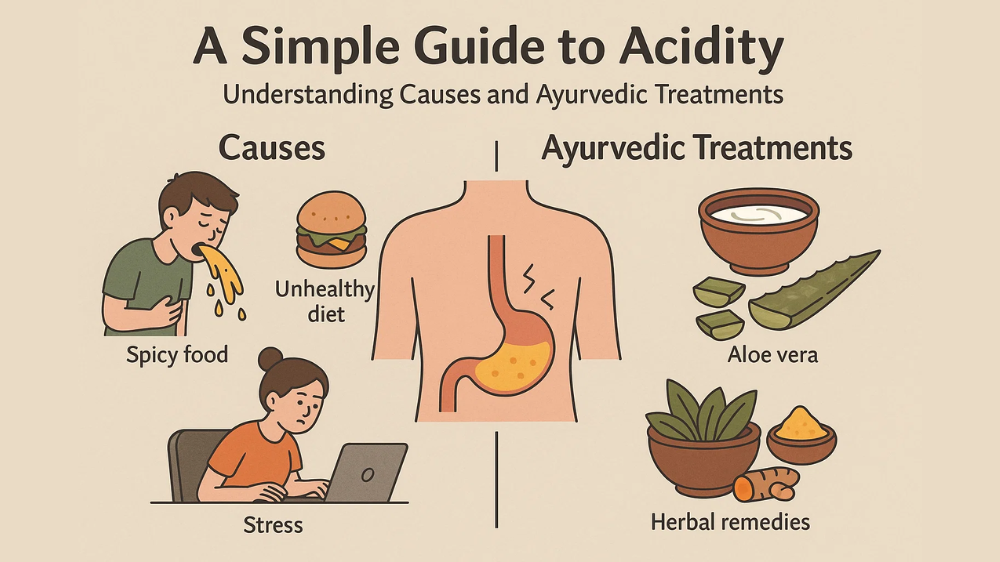Have you ever experienced a burning sensation in your throat and chest, accompanied by sour burps? That’s where acidity shows its most uncomfortable face. Commonly called acid reflux or heartburn, acidity, when it occurs frequently, can potentially interfere with your daily life, eating habits, and even sleep. Do you have an idea that acidity, once started occurring frequently, can cause harm to the internal lining of the oesophagus and stomach, which further can make your stomach vulnerable to serious infections and inflammations?
To get rid of this, individuals heavily rely on antacids and over-the-counter medications– but do you think it is helpful? First, they only suppress it, rather than curing it from scratch. Second, their prolonged or overuse can cause significant side effects such as diarrhoea, kidney issues, constipation, and nutrient imbalances. In fact, a lot of individuals have faced digestive function impairment. So, ask yourself– are these short-term reliefs or “quick fixes” even helping you? NO! They are only the best solutions when taken once or twice occasionally; heavy dependency and frequent use are not at all advised.
Individuals seeking long-term relief can consider the Ayurvedic approach for gastric treatment, which directly addresses the root cause. Let’s read on to know more about it in detail.
Table of Contents
- Understanding the Effects of Acid Reflux and Hyperacidity on the Digestive System
- Common Symptoms and Root Causes of Acidity
- Ayurvedic Understanding of Acidity
- Effective Ayurvedic Treatments for Acidity
- Diet and Lifestyle Recommendations for Long-term Relief
- Why Choose Tarunveda for Acidity Management and Care?
- Frequently Asked Questions
Understanding the Effects of Acid Reflux and Hyperacidity on the Digestive System
During acid reflux, a backflow of acid occurs, which impacts the lining of the oesophagus, leading to major symptoms such as sore throat, heartburn, regurgitation, and even chronic cough (in some cases). The more frequent the acidity becomes, the greater the chances for esophagitis (inflammation of the oesophagus) and the risk of ulcers or Barrett’s oesophagus.
Similarly, during Hyperacidity, an excessive production of gastric acid in the stomach can damage the mucosal lining, potentially interfering with the enzyme activity and degrading nutrient absorption. This can further lead to bloating, indigestion, nausea, and in severe cases, peptic ulcers, malnutrition, and even anaemia due to deficiencies in essential nutrients like iron and vitamin B12.
When acid reflux and hyperacidity occur together in frequent episodes, they can significantly disrupt the normal digestive environment.
Common Symptoms and Root Causes of Acidity
The most common symptoms of acidity include Nausea, indigestion, discomfort while lying down, abdominal pain, a severe burning sensation in the feet or hands, a sour or bitter taste in the mouth, post-meal heaviness, foul-smelling loose stools, headache, bloating, and heartburn.
In cases of chronic acidity, the symptoms worsen, accompanied by a dry cough, bad breath, throat irritation, and chest pain, which can be similar to symptoms of heart conditions.
The root cause of acidity is often attributed to the modern lifestyle and dietary habits. Some common ones include skipping meals, eating late at night, irregular meal timings, a sedentary lifestyle, consuming contrasting-property food items, Dehydration, lack of sleep or sleeping after meals, excessive caffeine intake, and fast eating, which can overload the digestive system and trigger excess acid production.
Ayurvedic Understanding of Acidity
According to Ayurveda, acidity primarily results from a disturbance of the Pitta dosha, which is the fire element responsible for heat, metabolism, and digestion in the body. In Ayurveda, acidity is referred to as Amlapitta, meaning “sour Pitta.” According to Ayurvedic principles, the root cause of acidity is directly linked to an overactive Agni (digestive fire). When Agni becomes either too strong or irregular, it digests food too quickly or improperly, leading to the formation of Ama (toxins), causing toxin buildup. This further irritates the stomach lining, resulting in symptoms related to acidity, as mentioned above.
Ayurveda takes amlapitta or acidity as a digestive dysfunction and dosha imbalance, where the treatment focuses on restoring balance through natural and effective remedies.
Effective Ayurvedic Treatments for Acidity
The Ayurvedic medicine for acidity is all about the expert administration of highly effective therapies, including:
- Administration of herbal therapies, which mainly include Amla (Indian Gooseberry), Avipattikar Churna, Licorice (Yashtimadhu), Guduchi, Shatavari, and Haritaki, is helpful in soothing, cooling, and calming the digestive system by pacifying excess acid production.
- Panchkarma Therapies, mainly including the Virechana Therapy (Purgation) to eliminate excess Pitta and Shirodhara and Abhyanga (oil therapies) to manage stress and support the gut-brain connection.
Other effective Ayurvedic medicines for acidity are Kamdudha Ras and Sutshekhar Ras.
Diet and Lifestyle Recommendations for Long-term Relief
Treating acidity is more about correcting your lifestyle and diet to get permanent relief. Here are the must-follow diet and lifestyle recommendations:
- Eating timely meals for a regulated digestive system.
- Prioritising home-cooked, light, and freshly-prepared meals and avoiding overly spicy, fried, or processed food.
- Including Pitta-pacifying foods like coconut water, soaked almonds, buttermilk, ripe bananas, and cooling herbs like coriander and fennel.
- Avoid fast eating and chew food slowly and mindfully.
- Avoid skipping meals, especially breakfast, as it’s the first meal of the day.
- Reducing caffeine, alcohol, carbonated drinks, and smoking as they trigger acidity.
- Staying hydrated. Drink warm or room-temperature water only.
- Avoiding overuse of painkillers or unnecessary medication, which can harm the stomach lining.
- Avoid lying down right after eating. A short walk for 5-10 minutes can help.
- Practising stress-reducing and stress-management activities like yoga, meditation, or journaling, which can help you effectively cope with emotional pressure and promote mental wellbeing.
- Including herbal teas like cumin-coriander-fennel, chamomile, or licorice to soothe the stomach naturally.
Why Choose Tarunveda for Acidity Management and Care?
At Tarunveda Ayurveda Hospital, all therapies and treatments are conducted under expert supervision, taking into account your body’s prakriti and individual requirements. The world-class facilities allow patients to experience holistic healing with a touch of expertise and personalised care.
From traditional therapies like Shirodhara and Panchakarma to customised herbal treatments and dietary plans, every aspect of your wellness journey is thoughtfully curated.
BOOK AN APPOINTMENT TODAY– Get ready to live a life free from unwanted acid punches!
Frequently Asked Questions About Ayurvedic Treatment for Acidity
Q1. How can hyperacidity be prevented?
Ans. You can prevent hyperacidity by avoiding heavy food (especially at night), along with smoking and alcohol. These can significantly cause hyperacidity in your body.
Q2. How does Amla Powder help in treating acidity?
Ans. Amla powder possesses powerful healing properties and helps prevent acidity by reducing stomach acid, soothing the stomach lining, and promoting healthy digestion.
Q3. Which fruits are best for treating acidity?
Ans. Try eating fruits like black grapes, dry grapes, pomegranate, and dry figs.
Q4. How is stress linked with acidity?
Ans. Stress can trigger or worsen acidity by increasing stomach acid production and slowing digestion. It also weakens the lower oesophageal sphincter, allowing acid to flow back into the oesophagus.








